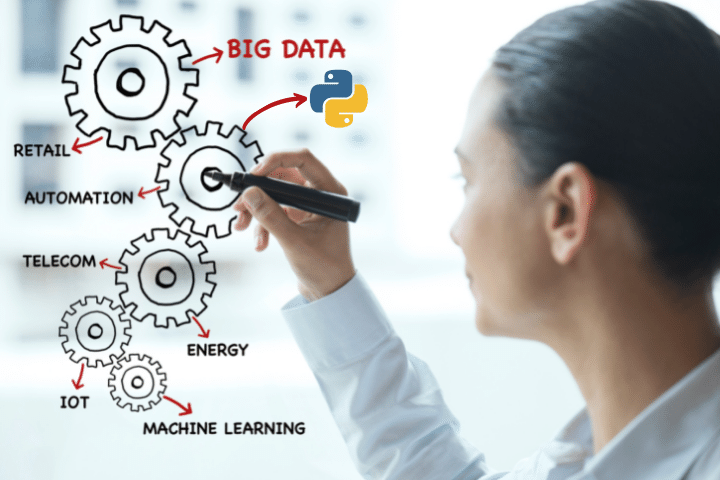Python in Big Data

In recent years, Python has become one of the most used programming languages in the world and without a doubt, in a short time, it will be the most used in the entire technology sector.
Python in Big Data projects
This exponential growth has been thanks to the birth of sectors such as artificial intelligence, machine learning, data analysis, data visualization or Big Data.
Python is undoubtedly the language par excellence in the world of data science or better known as data science.
More specifically, in the Big Data world it is widely used along with other languages such as Java or Scala to work with large amounts of data in a distributed way.
Python is used by many big brands that handle large amounts of information such as Google, Facebook or Netflix.
If you want to get started in the world of data and Big Data, learning Python will undoubtedly open many doors for you.
If you want to learn what benefits this programming language provides, stay tuned and we will tell you about it below!
Why choose Python for Big Data
We have seen that it is a very popular language for data scientists, Big Data engineers and machine learning engineers. But... What advantages does Python offer us that other languages do not have?
Low learning curve
Python's syntax is much simpler than other languages such as Scala, Java or C++. Its simplicity allows you to write fully functional programs in just a few lines of code, so the learning curve is very low. Anyone, in a few days of learning, can be programming simple programs.
A few years ago, Python's simplicity caused it to be slower than, for example, Java or C++. However, it has evolved in recent years, achieving very notable returns.
Its easy learning has lowered the barriers to entry and has allowed people who do not have a computer engineering background to start programming and learn different disciplines such as machine learning or data science.
Open Source
Another advantage is that it is open source like most libraries and frameworks designed for Python. This allows it to evolve and improve thanks to the collaboration of all the programmers.
Libraries for big data and data analysis
Python has a large number of packages and libraries specialized in handling large amounts of data, its processing and its subsequent visualization. Some of these packages are Pandas, Matplotlib, Numpy or Seaborn.
It has also become the preferred language for using voluminous data sets to create machine learning models. For this task we have libraries such as SKlearn, Pytorch, Tensorflow, Fastai, OpenCV or NLTK.
Large user community
Another advantage is the large community of users around the world who use Python. This means that if you have any questions or problems you can search large communities like StackOverflow to find your answer.
In addition, all libraries and packages are improving thanks to the fact that every user can propose improvements and upload them to repositories such as Github or Gitlab.
Big Data Frameworks Compatible with Python
Most Big Data frameworks are written in Scala or Java. However, they can be used in Python through the corresponding APIs. Below we give some frameworks that can be used in Python.
Hadoop
Pydoop is the Hadoop library for Python. It allows interaction with the Hadoop file system (HDF) in addition to providing tools for the execution of tasks in a distributed manner through MapReduce.
Spark
Pyspark is the version of Spark for Python. Within the package we will find Spark SQL, Spark Streaming and Spark MLlib that work on top of the Spark core.
Therefore, we can use all the native features of Spark through the API for Python without having to learn Scala or Java.
Hive
Hive is a technology that allows queries on large data sets stored on HDFS. Hive works on top of Hadoop in a distributed way and has an API that allows its interaction with Python.
Alternatives to Python for data science
There are other popular programming languages in the data world that share many of the benefits of Python.
R is a language designed to be used in statistics. It is widely used for data visualization, for its manipulation and for its subsequent visualization since it has native packages that allow complex visual analysis. However, it is not widely used for technologies with huge volumes of data.
In Big Data, the most used are undoubtedly Java and Scala in addition to SQL to make requests to databases.
Learning these languages will be very useful to you since many of the tools that use data in a distributed way in different nodes are programmed natively in Java or Scala.
Don't panic! Once you learn to program professionally in one programming language, the others will be much easier and in a short time you will be able to master them without any problem.

